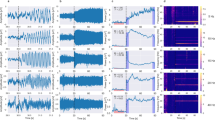Summary
Amplitudes and latencies of components of visual evoked potentials (VEPs) were analysed during the 24-h cycle in humans. Circadian variations of other physiological parameters (oral temperature, urine volume and urinary potassium excretion) and of psychomotor performance (grip strength, tapping rate, visual reaction time and performance on a letter cancellation test) were also assessed. Eight male volunteers (aged 20–34 years) were tested twice over a period of 30 h. Test sessions took place every 3 h (1100 hours, 1400 hours etc.). VEPs were elicited by checkerboard pattern reversals. Significant circadian variations in the VEPs were found for the latencies of the P100 and N140 components, which were longest between 2 a.m. and 5 a.m. (P100: 103 ms; N140: 138 ms) and shortest at about 5 p.m. (P100: 97 ms; N140: 130 ms). Pronounced circadian variations were also observed in physiological parameters and in psychomotor performance measures. Circadian variation of oral temperature was correlated with the 24-h profiles of most of the other variables. Time courses of VEP latencies and oral temperature were moderately negatively correlated. However, from the data presented it seems premature to conclude that there is a common pacemaker for the circadian variations of the different parameters investigated.
Similar content being viewed by others
References
Aschoff J, Fatranska M, Gerecke U, Giedke H (1974) Twenty-four-hour rhythms of rectal temperature in humans: effects of sleep-interruptions and of test-sessions. Pflügers Arch 346:215–222
Aschoff J, Wever R (1980) Über Reproduzierbarkeit circadianer Rhythmen beim Menschen. Klin Wochenschr 58:323–335
Aschoff J, Wever R (1981) The circadian system of man. In: Aschoff J (ed) Handbook of behavioral biology, vol 4. Plenum Press, New York, pp 311–329
Bobbert AC, Krul WH, Brandenburg J (1978) Diurnal changes in the rabbit's visual evoked potential. Int J Chronobiol 5:307–325
Brickenkamp R (1962) Test d2. Handanweisung. Verlag für Psychologie, Göttingen
Browmann CP (1979) Diurnal variation of the human auditory evoked potential. Physiol Psychol 7:287–290
Browmann CP, Sullivan HT (1980) Diurnal periodicity of the human vertex potential. Percept Mot Skills 51:643–646
Brown FM, Graeber RC (eds) (1982) Rhythmic aspects of behavior. Erlbaum, Hillsdale, NJ
Davis GC, Buchsbaum MS, Bunney WE Jr (1978) Naloxone decreases diurnal variation in pain sensitivity and somatosensory evoked potentials. Life Sci 23:1449–1460
Ermolaeva R, McLaughlin B, Cameron R (1978) Visual evoked responses in dark and light adapted subjects. Electroencephalogr Clin Neurophysiol 44:791
Giedke H, Fatranska M (1974) Tagesperiodik der Rektaltemperatur sowie der Ausscheidung von Elektrolyten, Katecholaminmetaboliten und 17-Hydroxycorticosteroiden mit dem Harn beim Menschen mit und ohne Lichtzeitgeber. Int Arch Arbeitsmed 32:43–66
Goff WR, Allison T, Vaughan HG Jr (1978) The functional neuroanatomy of event-related potentials. In: Callaway E, Tueting P, Koslow S (eds) Event-related brain potentials in man. Academic Press, London, pp 1–79
Halliday AM, Michael WF (1970) Changes in pattern evoked responses in man associated with the vertical and horizontal meridians of the visual field. J Physiol (Lond) 208:499–513
Heninger GR, McDonald RK, Goff WR, Sollberger A (1969) Diurnal variations in the cerebral evoked response and EEG. Arch Neurol 21:330–337
Hildebrandt G, Engel P (1972) The relation between diurnal variations in psychic and physical performance. In: Colquhoun WP (ed) Aspects of human efficiency. English University Press, London, pp 231–240
Hockey GRJ, Colquhoun WP (1972) Diurnal variation in human performance: a review. In: Colquhoun WP (ed) Aspects of human efficiency. English University Press, London, pp 1–23
Kerkhof GA, Korving HJ, Willemse van de Gest HMM, Rietveld WJ (1980) Diurnal differences between morning-type and evening-type subjects in self-related alertness, body temperature and the visual and auditory evoked potential. Neurosci Lett 16:11–15
Marshall NK, Donchin E (1981) Circadian variation in the latency of brainstem responses and its relation to the body temperature. Science 212:356–358
Menzel W (1962) Menschliche Tag-und-Nacht-Rhythmik und Schichtarbeit. Schwabe, Basel
Moore-Ede MC, Sulzman FM, Fuller CA (1982) The clocks that time us. Harvard University Press, Carmbridge, Mass
Pillunat LE, Stodtmeister R, Wilmanns I (1987) Pressure compliance of the optic nerve head in low tension glaucoma. Br J Ophthalmol 71:181–187
Spekreijse H, Estevez O, Reits D (1977) Visual evoked potentials and the physiological analysis of visual processes in man. In: Desmedt JE (ed) Visual evoked potentials in man: new developments. Oxford University Press, Oxford, pp 16–89
Ulrich WD, Ulrich C, Bohne BD, Niederlaender C (1986) Relationship between ciliary perfusion pressure and pattern-reversal visual evoked cortical potentials: an electro-encephalo-dynamographic investigation. Ophthalmic Res 18:253–259
Zimmerman TJ, Dawson WW, Fitzgerald CR (1973) ERG in human eyes following oral adrenocorticoids. Invest Ophthalmol 12:777–779
Author information
Authors and Affiliations
Additional information
Dedicated to Prof. Dr. H. H. Kornhuber on the occasion of his 60th birthday
Rights and permissions
About this article
Cite this article
Stolz, G., Aschoff, J.C., Born, J. et al. VEP, physiological and psychological circadian variations in humans. J Neurol 235, 308–313 (1988). https://doi.org/10.1007/BF00314180
Received:
Revised:
Accepted:
Issue Date:
DOI: https://doi.org/10.1007/BF00314180




